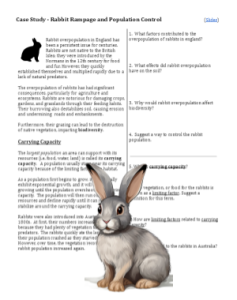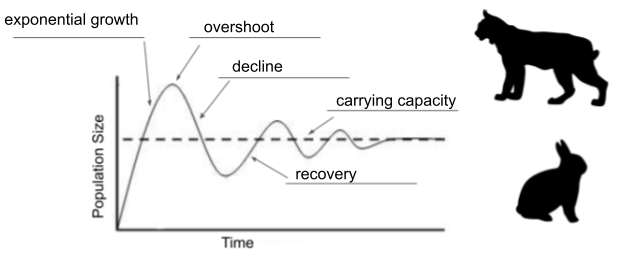
European settlers introduced rabbits to both England and Australia. In the absence of natural predators, rabbits were able to multiply rapidly and establish large populations. Rabbits are prolific breeders, with females capable of producing several litters of offspring each year. This high reproductive rate allows rabbit populations to grow exponentially under favorable conditions.
The case begins with the historic introduction of rabbits to England in the 12th century. Originally, humans imported rabbits for hunting as as a food source. The rabbit populations quickly grew out of control, damaging the ecosystem. For instance, native herbivores, like deer were impacted. Rabbits even caused erosion damage to soil, further limiting biodiversity.
Students learn that in most cases, animal populations have limiting factors that keep their numbers at a near stable level, the carrying capacity. Without limiting factors, the population can grow exponentially, as the rabbits did.
Next, students learn that the population of rabbits, having eaten all the vegetation, had a massive die off. Not all rabbits died, and their numbers recover quickly, known as a “Boom and Bust Cycle.” In both areas where rabbits were introduced, humans tried a number of measures to control the population. These included hunting and poisoning rabbits to reduce their numbers. However, none of the measures have worked well. In other areas, the myxoma virus reduced rabbit population numbers, though over time, the virus has become less effective. Go, evolution!
Finally, students examine a graph showing a logistic growth pattern. Limiting factors, such as food availability and predation, will keep the number of rabbits near the carrying capacity. In some areas of Europe, ecologists reintroduced the lynx, which is a natural predator of rabbits and helped to control the rabbit populations. A follow-up activity explores the lynx and conservation efforts.

Related Activities
Case Study – Loggerhead Turtles and Population Models – explore the number of eggs hatched and survivorship
Ecology Case Study – The Wolves of Isle Royale – population decline and reintroduction of wolves
Predator Prey Graph – graph data on deer and wolf populations (growth curves)
Saving a Fussy Predator – reintroduction of the lynx to control rabbit populations
Rabbit Skeleton – model for use in comparative anatomy, showing teeth and skeletal features
Rabbit Digestive System – label the rabbit digestive system for comparative anatomy units

